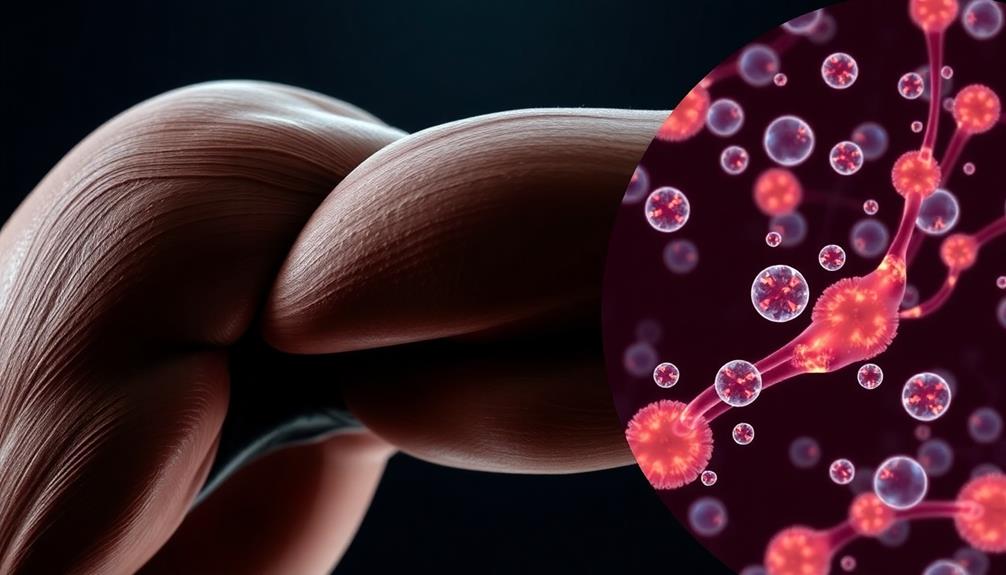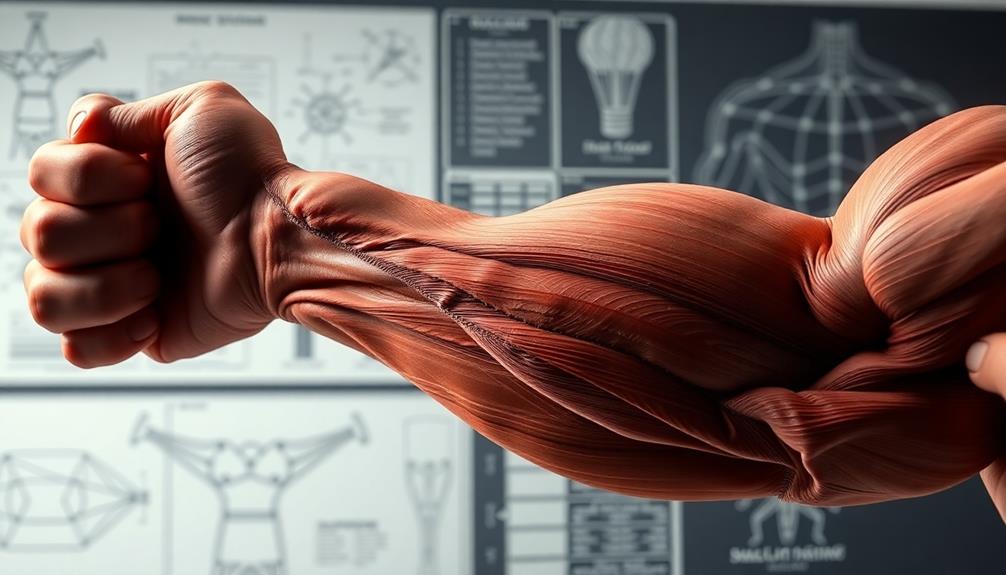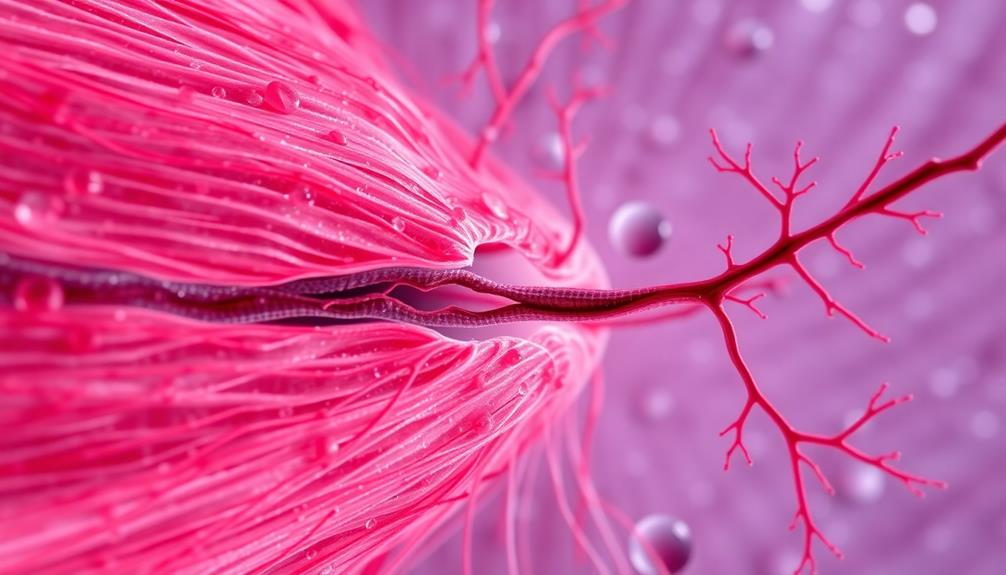To access hypertrophy, you'll need to understand the science behind muscle growth. Focus on three key mechanisms: mechanical tension, metabolic stress, and muscle damage. Incorporate exercises that create muscle tension, like heavy compound lifts. Use high-rep sets and short rest periods to induce metabolic stress. Allow for proper recovery to repair muscle damage. Gradually increase weight or reps over time, aiming for 6-12 reps per set. Consistency is pivotal, as is tracking your progress and adapting your routine. Remember, muscles grow during rest, not during exercise. By applying these principles, you'll optimize your training for effective muscle development. Discover how to fine-tune your approach for maximum gains.
Core Insight
- Combine mechanical tension, metabolic stress, and muscle damage to optimize hypertrophy.
- Focus on compound exercises and progressive overload to stimulate muscle growth effectively.
- Utilize varied rep ranges, emphasizing 6-12 reps per set for optimal hypertrophy.
- Ensure adequate protein intake and rest between workouts for muscle repair and growth.
- Incorporate techniques like drop sets and supersets to increase metabolic stress and muscle adaptation.
Understanding Hypertrophy Mechanisms

Muscle growth, or hypertrophy, happens when muscle fibers get bigger. There are two main ways this occurs: myofibrillar hypertrophy and sarcoplasmic hypertrophy. Myofibrillar hypertrophy is when the muscle's strength and density increase due to the growth of contractile proteins. Sarcoplasmic hypertrophy is when the fluid and energy-storing parts within muscle cells expand. While steroids can speed up muscle growth, there are safer options that support natural muscle development without the risks.
To trigger muscle growth, you need to create mechanical tension, metabolic stress, and muscle damage through weight training. Lifting heavy weights creates mechanical tension, while doing higher-rep sets with shorter rest periods leads to metabolic stress. Muscle damage may also play a role in growth by starting repair processes. By understanding these mechanisms, you can create effective workouts that target different aspects of muscle development.
Mechanical Tension and Muscle Growth

Mechanical tension plays a key role in muscle growth. When you lift weights, you put force on your muscles. This creates tension that makes your muscles bigger and stronger. Three main things affect this process: how heavy the weight is, how long your muscles are under stress, and gradually increasing the weight over time.
To get the best muscle growth, focus on exercises that let you lift heavy weights with controlled movements. Squats, deadlifts, and bench presses are great choices. It's not just about lifting a lot of weight. You also need to keep tension on your muscles through the whole movement. By using these ideas in your training, you'll get the most muscle growth possible.
Metabolic Stress in Muscle Building

Metabolic stress is another important factor in building muscle. It happens when you do exercises that cause a buildup of waste products in your muscles, like lactic acid. To get the best results from your workouts, it's crucial to understand and apply these scientific concepts.
To create metabolic stress, focus on doing high-repetition sets with short rest periods. You can also try techniques like drop sets or supersets. These methods reduce blood flow to the working muscles, making an environment with less oxygen that helps muscles grow.
When you feel the "burn" during exercise, that's metabolic stress doing its job. It causes your body to release more hormones, makes your muscle cells swell, and increases protein production. All of these things help your muscles get bigger, even if you're not using heavy weights.
Muscle Damage and Repair Process

When you lift weights, you create tiny tears in your muscles. This damage makes your body repair the muscles, which leads to muscle growth. Sleep is key for this process because it helps your body recover after exercise and fixes your muscles by controlling hormones.
Your body fixes the tears by making more proteins and using special cells called satellite cells. These cells join with your muscle fibers, making them able to create more proteins. As you keep working out, your muscles get used to this and grow bigger and stronger.
To make this process work best, eat enough protein and give your muscles time to rest between workouts. Keep in mind, your muscles grow and repair when you're resting, not while you're actually working out.
Optimal Training Techniques for Hypertrophy

Building muscle effectively requires a smart training plan. Here are the most important things to focus on:
Choose exercises that work multiple muscles at once, like squats and bench press. Gradually increase the weight or number of reps over time. Slow down the lowering phase of each rep to keep your muscles working longer.
Aim to do 10-20 sets per muscle group each week, spread across a few workouts. Rest 1-2 minutes between sets. Mix up your exercises to target muscles from different angles.
Most of your sets should have 6-12 reps. This rep range works best for muscle growth. Make sure to rest enough between workouts so your muscles can recover and grow. This is when the actual growth happens.
Eating right and staying hydrated are also crucial. Protein, carbs, and healthy fats give your body the building blocks it needs to build muscle.
The key is to stay consistent with your plan. Keep challenging yourself but adjust if needed based on how your body responds. Track your progress and keep pushing forward. Building muscle takes time and effort, but you'll get there!
Nutrition Strategies for Muscle Development

Muscle growth relies heavily on proper nutrition. To build muscle effectively, focus on consuming enough protein, eating slightly more calories than you burn, and timing your nutrients wisely.
Protein is essential for repairing and growing muscle tissue. Aim to eat 1.6-2.2 grams of protein per kilogram of your body weight each day. Choose high-quality protein sources that are easy for your body to digest and use.
To support muscle growth, you'll need to eat more calories than your body burns. Aim for a surplus of 300-500 calories per day. Keep track of your progress and adjust your calorie intake as needed.
Spread your protein intake evenly across several meals, eating every 3-4 hours. Have a meal with both protein and carbohydrates before and after your workouts. This will provide energy for your training and help your muscles recover afterward.
Recovery Methods for Maximizing Gains

Sleep, active recovery, and stress management are three important ways to help your muscles grow bigger and stronger.
Sleep: Try to get 7-9 hours of good sleep every night. While you're in deep sleep, your body makes a special hormone that fixes and builds your muscles. Go to bed and wake up at the same times each day. Make your bedroom dark, quiet, and cool. Drink enough water, too. This helps you sleep well and recover. You can even try special gummies with electrolytes to keep your body balanced.
Active Recovery: On days you don't lift weights, do easy exercises like walking or stretching. This gets your blood moving, helps with sore muscles, and cleans out the junk that builds up.
Stress Management: Too much stress can stop your muscles from growing. It makes your body release a hormone called cortisol. To keep stress low, try deep breathing, relaxing hobbies, or meditation. This lets your body focus on fixing and growing your muscles.
Frequently Asked Questions
How Does Age Affect Hypertrophy Potential and Training Adaptations?
As you age, your hypertrophy potential typically decreases. You'll experience slower muscle growth, reduced hormone production, and slower recovery. However, you can still make gains with proper nutrition, consistent training, and adequate rest between workouts.
Can Genetics Limit One's Ability to Achieve Significant Muscle Hypertrophy?
Yes, genetics can limit your hypertrophy potential. You're born with a certain number of muscle fibers and muscle-building hormone levels. However, you can still make significant gains through proper training and nutrition, regardless of your genetic predisposition.
What Role Do Hormones Play in Muscle Growth and Hypertrophy?
Hormones play a vital role in your muscle growth. They're essential for protein synthesis, muscle repair, and energy metabolism. Testosterone, growth hormone, and insulin-like growth factor-1 are key players in promoting hypertrophy and strength gains.
How Does Sleep Quality Impact Muscle Hypertrophy and Recovery?
Quality sleep boosts your muscle growth and recovery. It enhances hormone production, including growth hormone and testosterone. You'll repair muscle tissue faster, reduce inflammation, and improve protein synthesis. Don't skimp on sleep for best hypertrophy results.
Are There Differences in Hypertrophy Mechanisms Between Men and Women?
Yes, there are differences in hypertrophy mechanisms between men and women. You'll find that men generally have higher testosterone levels, leading to faster muscle growth. Women often have better endurance and may benefit more from higher-volume training.

